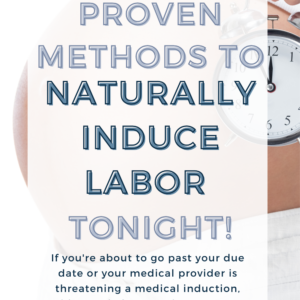Unmedicated natural birth can be hard, but it doesn’t have to be! These natural birth pain management techniques will make natural birth painless and enjoyable. #3 is a must!

Natural Birth Pain
When our bodies are thrown into a situation that feels threatening, our natural response is fight or flight. You either fight the situation or your run away. With flight, you flee and give up, reaching for the epidural. When you fight, you fight your body, not allowing it to do what it needs to do for childbirth. Neither one of these responses is helpful if your goal is an unmedicated natural birth.
It’s natural for us to go into fight mode when contractions become difficult. It hurts, so our body’s natural response is to fight. You will become tense, clench your jaw, or scream. You will do it all without realizing. This reaction is natural, but it’s also what will ruin your chance of natural birth. The more you fight the process, the more it will hurt.
A contraction has a lot of work to do. It cramps your abdominal and uterine muscles to dilate and efface your cervix. Each contraction slowly opens and effaces your cervix until your 10cm and 100% effaced. If you fight the contraction, your body now has to work twice as hard because you’re working again it. Birth will take longer and be much more painful this way.
These natural birth pain management tips will give you an excellent head start. You will neither fight nor fight your birth. Instead, using these tips, you will be able to work with your body for an easy, fast and healthy unmedicated natural birth.
Natural Birth Pain Management Strategies
1. | Relax
You will be able to handle all of natural birth pain if you are able to relax. Contractions can be painful. The level of pain you feel will depend on your ability to relax. Relaxation means to be less mentally and physically tense and anxious. It’s a mindful practice that resonates through the body.
A body goes into flight or fight response due to shock. It’s the body’s way of protecting itself until the mind catches up to what’s going on. You will fight contractions unless you can relax and let the mind signal to your body that you are okay. The more you focus your mind, the more you will relax and the easier labor will be.
There are a lot of ways to relax, but they can vary from person to person. It’s good to make a list and practice what works for you. When labor gets tough, you will have a few relaxation practices ready to go that you can fall back on. Here are a few suggestions:
Breath
You want to take slow, rhythmic deep breaths in and out through the nose and mouth. Focus and control breath. Lamaze breathing has become well-known for natural birth pain management. No matter what you call it, focusing on your breath is key during labor.
Slowly count to 5 as you breathe in through your nose. Exhale all of your breath through the mouth. As you exhale, think about breathing out the pain and releasing the tension. The more you focus on controlled, deep breathing, the more you won’t focus on contraction pain.
[convertkit form=2014392]
Mental Imagery
Focusing on your breath is one way to take your mind off of contractions. Another way is mental imagery. The best way to use mental imagery is to imagine each contraction like a wave. Your job is to simply relax and float over the wave like you’re on a raft. As the wave peaks and is about to break, that’s the hardest part of your contraction. It will get easier and easier until you get a break.
Birth Environment
Birth environment is essential in labor not matter where you labor but especially at a hospital. It directly impacts your ability to focus. Labor can even stall when you change environments if your body sense you’re uncomfortable and unable to relax.
Create a birth environment that appeals to your five senses. Think about what you’d you like to see, touch, taste, smell and hear that allows your to relax. It might be lavender in a diffuser. You could eat ice chips and drink coconut water. It may be a hand to squeeze. Bring your own birth robe and sheets.
A lot of women have adverse reactions to various smells, tastes and things touching them. This especially happens in transition. Your birth environment may change throughout labor. Be sure to be vocal and say what you do and don’t need for your birth environment and relation.
[convertkit form=1778735]
Moaning
Every movie where a woman gives birth, the scene makes it look scary and hard! Or maybe you’ve been in the delivery room or heard stories like this. Women who don’t prepare themselves for natural birth don’t handle natural birth pain well, and they scream!
Screaming is panicking. Instead, practice low moaning in oohhsss and aaahhhsss. Imagine your mouth mirrors your cervix. Unclench your jaw, open your mouth and sigh a low moan. This helps your body to relax. It also gives you something to focus on during each contraction. Soft jaw, open mouth, moan.
2. | Birth Positions
If you labor in a hospital, it’s critical that you discuss you birth plan before labor. You may find a position that you retreat to for each contraction. Or you need to change positions several times. What is important to know is that you have options.
Laying in a bed or not having mobility can stall labor. Baby needs movement to wiggle into the he perfect spot for birth. Your body needs the movement and pressure to open your cervix. Intermittent or mobile fetal motoring is a non-negotiable for birth. Double check that your provider supports this by asking her ahead of time.
Related: Natural Birth Questions You Must Ask Your Doctor
3. | Water
Water has a lot of soothing qualities about it. It helps people relax, release tension and provide calm and focus. It’s such a powerful resource in birth that I recommend saving it for last. It’s why water births have become so popular.
Transition is the hardest part of labor. You’ll hit the self-doubt sign post and feel like giving up. Instead, get in the shower and let the water run over your back or belly (wherever you feel contractions most). Listen to the running water. Focus on the sound. Enjoy the heat on your body. Imagine the running over your body takes the pain away with it.
Birthing centers or home births will better afford you the ability to take a bath or jump in the shower. If you birth at a hospital, check with your provider what is allowed, so you don’t miss out on this powerful pain management strategy.
[convertkit form=1775019]
4. | Birth Affirmations
I couldn’t have made it through my first natural labor without my husband’s spoken words. There will become a time when you hit the serious sign post, and your contractions take all of your energy. You will need to focus entirely. It’s easy at this point to simply forget a lot of your practices and education.
This is where having a support person comes in key. Prepare birth affirmations ahead of time for your support person to give you. Before you `go into labor, give them tips on what they can say to help you relax and focus. Have them remind you to focus on your breath. They can tell you how strong you are. A support person can even help you with mentally, explaining the wave imagery as you travel through every contraction.
5. | Prepare
The best way to lessen natural birth pain is by preparing. The more you prepare for birth, the easier it will be.
Practice different birth positions. This creates muscles memory to fall back on in labor. Use your third trimester to eat natural birth foods to soften and dilate your cervix. Write birth affirmations and notes for you and your support person.
Related: Why You Need to Start Preparing for Natural Birth Now
Conclusion
Natural birth can be hard, but it doesn’t have to be! Use these natural birth pain management techniques to ease contractions. Remember to relax and let your body do what it knows how to do. Focus your mind with birth affirmations. Change birth positions to ease pain and find comfort. Lastly, don’t forget to start preparing for unmedicated natural birth now.











Leave a Reply